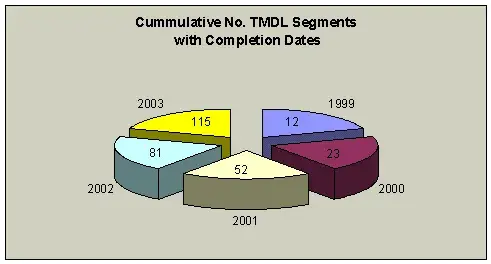TMDL Background Information
Section 303(d) of the Clean Water Act (CWA) requires states to submit a list (303(d) List) of surface waters that do not meet applicable water quality standards (impaired waters) for which implementation of technology-based effluent limitations alone do not ensure attainment of applicable water quality standards. The list of impaired waters includes priority rankings for establishment of Total Maximum Daily Loads (TMDLs) for these waters.
Once the impaired waters are identified, Section 303(d) requires that the states establish total daily maximum loads (TMDLs) that will meet water quality standards for each listed water, considering seasonal variations and a margin of safety (MOS) that accounts for uncertainty. TMDLs establish the maximum amount of a pollutant that a water body can assimilate without causing exceedances of water quality standards.
What is a TMDL?
A TMDL is a tool for reducing water pollution in impaired waters. A TMDL calculates the amount of a pollutant that the waterbody can receive and still meet applicable water quality standards. Basically, a TMDL is the sum of the allowable loads of a single pollutant from all contributing point and nonpoint sources with a margin of safety (MOS) that accounts for uncertainty. The TMDL also addresses reductions needed to meet water quality standards and allocates those reductions among the point and nonpoint sources in the watershed. As such, development of TMDLs is an important step toward restoring our waters to their designated uses.
How are TMDLs Developed?
TMDLs are developed for the most critical environmental conditions, i.e., stream flow, temperature, weather conditions, etc., using data compiled in a particular geographic area or watershed from reliable sources. Scientifically accepted mathematical methods that represent what is happening in nature are used to develop the TMDL. A GIS (geographic information system) format may also be used to provide the framework for the model's information, particularly land use distributions. Data and information may include the relative contribution of different kinds of activities like point and nonpoint sources of pollutants. All of this information is then used to propose a TMDL that is appropriate for the specific water body.
What does a TMDL include?
A TMDL will include loads from point sources (such as municipal and industrial wastewater treatment facilities) and nonpoint sources (such as direct runoff from agricultural lands, urban areas, forested lands, etc.) in the watershed. TMDLs will look at impacts on waterbodies from many kinds of contamination, will consider seasonal variations, and will account for background levels of pollutants (those levels occurring in nature). TMDLs compare current loads and proposed loads with expected levels of reduction to achieve the water quality standards.
What is the TMDL development schedule?
Settlement of a lawsuit filed against EPA Region 4 in 1998 (1998 Consent Decree) established a schedule for TMDL development in Alabama. The schedule is based on Alabamas 1996 §303(d) list, which included 115 waterbodies. The schedule requires that all 115 waterbodies be addressed by November 5, 2003 either by developing TMDLs or by delisting waters that can be shown to be fully supporting their designated uses. A list of TMDLs that Alabama has targeted for development over the next two years has been submitted to EPA (TMDL Schedule ).
1998 Consent Decree Completion Dates:

When does the public become involved?
The Clean Water Act and EPA's implementing regulations provide for stakeholder involvement in the TMDL development. The public may participate in the TMDL development and implementation process through watershed organizations such as the Alabama Clean Water Partnership. Also, anyone is welcome to comment on a TMDL during the public notice period for the TMDL. A 30-day public notice period will be held following the publication for each TMDL. Any comments received during the public notice period will become a part of the TMDL administrative record, and will be considered by ADEM prior to finalizing the TMDL report.
What is the TMDL approval process?
Following the public review and comment period and any necessary revisions, the states are required to submit their TMDLs to EPA for approval (EPA Approved TMDLs) (Approved TMDL Shapefiles) and, once EPA approves them, are to incorporate them into their permitting and watershed management programs. EPA must approve or disapprove state TMDLs within 30 days of final submission (TMDLs Waiting EPA Approval ). If EPA disapproves a state TMDL, EPA must establish the TMDL.
How are TMDLs Implemented?
Implementation of TMDLs refers to any combination of regulatory, non-regulatory, or incentive-based actions that attain the necessary reduction in pollutant loading. Non-regulatory or incentive-based actions may include development and implementation of Best Management Practices (BMPs), pollution prevention activities, and habitat preservation or restoration. Regulatory actions may include issuance or revision of wastewater and stormwater permits to include permit conditions consistent with the TMDL. These permit conditions may be numeric effluent limitations or narrative requirements based on BMPs needed to achieve the necessary pollutant load reduction.

